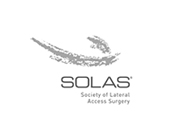Lateral Lumbar Interbody Fusion (LLIF) /
Extreme Lateral Interbody Fusion (XLIF)
The back is made up of a number of small bones called vertebrae. Cushioning discs present between the vertebrae act as shock absorbers. The vertebral column allows the cylindrical bundle of nerve fibers called the spinal cord to pass through the entire column length and branch out to the various parts of the body. Any damage or deformity to the bones of the vertebral column or to the intervertebral discs can damage these nerves, leading to pain in the body part that the nerve supplies.
Lateral lumbar interbody fusion also known as extreme lateral (XLIF) or direct lateral interbody fusion (DLIF) is a minimally invasive spinal procedure performed to treat back and leg pain caused by degenerative discs and other problems within the vertebral column. Interbody fusion involves the fusing of the affected vertebrae found in the lumbar region (lower back). In lateral lumbar interbody fusion, your doctor will access the spine from incisions made in your side.
Indications
Lateral lumbar interbody fusion is indicated for:
- Degenerative disc disease: wearing out of intervertebral discs with age
- Scoliosis: abnormally curved spine
- Spinal stenosis: narrowing of the spinal canal
- Spondylolisthesis: slipping of vertebra from their normal position
- Fractures
- Infections and
- Tumor
XLIF is not recommended in the following situations:
- When the displacement of the vertebrae in degenerative spondylolisthesis is greater than 50%
- Severe compression of a spinal nerve
- Presence of scarring from prior surgery or abscess
Surgical procedure
When medication and conservative treatments fail to improve your back pain, your doctor may recommend a lateral lumbar interbody fusion procedure (XLIF).
XLIF usually takes about one hour and is performed under general anesthesia. You will be placed on the operating table, positioned on your side. Your surgeon will use X-rays to identify the location of the degenerated disc and will mark your skin over this area of your spine. A small incision is made in your lower back region through which your surgeon inserts a finger to protect the abdominal lining from the instruments to be inserted laterally. Your surgeon will then make a second incision on your side in order to introduce the operating instruments. X-rays and nerve monitoring devices are used during the procedure to prevent damage to the adjacent tissues and nerves.
Your surgeon removes the degenerated intervertebral disc and prepares the disk space for fusion. A stabilizing disk implant is inserted into the empty disc space. The implant may be filled with bone graft, which will help in the fusion of the two vertebrae. The implant helps maintain proper disk height and provides good support to the operated spinal segment. In some cases your surgeon may secure the implant with plates or screws for additional support. Once the implant is in position, final X-rays are taken to confirm proper placement of the implant. At the end of the procedure, the small skin incisions are closed with stitches and bandaged.
It should be noted that post/operatively, patients may experience a temporary feeling of soreness, weakness, or even numbness in the hip flexor on the side of the LLIF/XLIF surgery. This is due to the need to traverse or mobilize the hip flexor (psoas) muscle at the time of surgery.
INDIRECT DECOMPRESSION:
LLIF/XLIF relies on a concept called ‘indirect decompression’. This means that Dr. Murray is able to remove the pressure from the spinal nerves without having to strip muscles from the spine and without having to remove the body’s natural covering of the spinal nerves (the lamina). Therefore, Dr. Murray is able to treat neurologic compression (spinal stenosis) without placing the spinal nerves at risk for injury, spinal fluid leak, or epidural fibrosis (the potentially painful development of post-operative scar tissues around the nerves).
Not only does the technique of XLIF/LLIF eliminate some of the risks of traditional surgery, it also optimizes recovery time and decreases the length of stay when compared to traditional spine fusion surgery. For a one level fusion, Dr. Murray’s length of stay in the hospital has been 1.4 days. This is compared to a 3-5 day hospital stay with traditional spinal fusion (ref).
The practice of ‘indirect decompression’ is well accepted amongst the leaders of minimally invasive surgery. However, this technique requires mastery of the XLIF/LLIF technique and is frequently unfamiliar to surgeons that perform traditional open spinal surgery. When performed by an expert, the success of indirect decompression is over 98% (Thomas et al, 2020, Journal of Neurosurgery).
Dr Murray has taught LLIF/XLIF and the technique of indirect decompression to spinal surgeons around the country and is a nationally recognized expert in this field.
Post-Operative Care
Recovery from lateral lumbar interbody fusion procedure varies from patient to patient. Depending on your condition you may be able to return home the same day after the procedure, or may have to stay in the hospital for a few more days. You may notice an immediate improvement in your symptoms after the surgery or they symptoms may disappear gradually. You may experience some pain at the incision sites. This is quite normal; your doctor may prescribe pain medications to alleviate your discomfort. As there is less damage to the adjacent tissues, you may be able to get up and walk around the night after your surgery. Most patients are usually able to return to their normal activities within a few months after XLIF.
Advantages
The advantages of XLIF include
- Minimally invasive procedure which requires less surgical time reducing your time under anesthesia.
- Less pain, scarring and blood loss as the procedure causes less damage to the adjacent tissues.
- Ensures early recovery and faster return to your normal activities.
Risks and complications
As with any procedure, XLIF is associated with certain risks and complications including:
- Formation of blood clots or deep vein thrombosis
- Improper fusion of the implant
- Injury to adjacent tissues
- Nerve or spinal cord damage
- Infection
- Pneumonia
- Urinary tract infection
- Stroke






